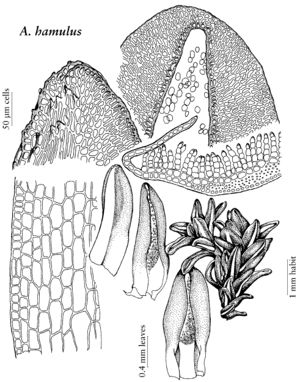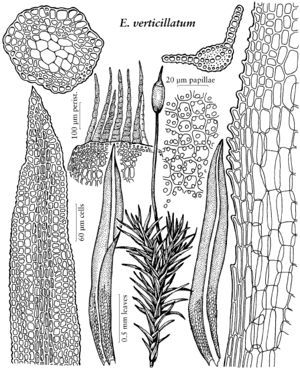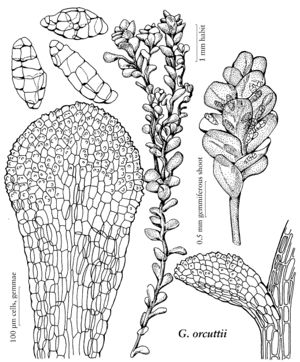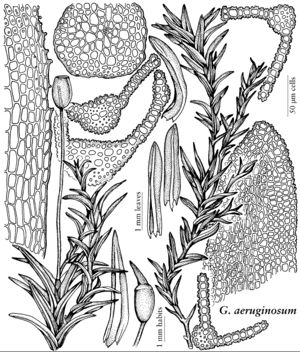Pottiaceae
Plants usually turf-forming or loosely cespitose, green distally and brown proximally. Stems 0.2–4 (–10) cm, irregularly branching, mostly rounded-pentagonal but occasionally rounded-triangular in section, hyalodermis usually absent, sclerodermis sometimes present, central strand usually present, radiculose, occasionally bare or tomentose, axillary hairs several cells in length, sometimes the proximal 1–3 cells brownish. Stem-leaves usually appressed and often contorted when dry, spreading when wet, ovoid to lanceolate or lingulate, often channeled or keeled, rarely concave, mostly ca. 1.5–3.5 mm; base usually ovate to oblong, occasionally sheathing the stem; margins usually recurved proximally, occasionally plane, incurved, or involute, entire or sometimes dentate distally, occasionally bordered by thick-walled or elongate cells or cells in one or more layers; apex rounded-obtuse to more commonly narrowly acute; costa ending a few cells before the apex to short-excurrent or long-excurrent as an awn, sometimes with photosynthetic outgrowths adaxially, adaxial cells quadrate or elongate in usually 2–4 rows, costa in medial transverse-section usually with a differentiated epidermis adaxially or on both sides, 1 or 2 stereid bands, the abaxial stereid band usually rounded or reniform, guide cells in 1 (–3) layers, hydroid strand occasionally present (sometimes multiple); basal laminal cells usually differentiated, smooth or lightly papillose, rectangular, generally filling the base medially, sometimes rising marginally in a V shape, occasionally bulging, usually slightly wider than the distal laminal cells; distal laminal cells usually subquadrate, occasionally hexagonal or rarely shortrectangular or rhomboid, mostly small, ca. 9–16 mm wide, 1: 1, papillae usually present over the distal laminal cells, solid or occasionally hollow, usually 2-fid but occasionally simple, sometimes flattened or compound, cell-walls mostly evenly thickened, superficially flat to bulging, sometimes bulging only adaxially, usually in one layer. Specialized asexual reproduction common, by multicellular (rarely 1-cellular) gemmae borne on stalks in the leaf-axils or more seldom on leaves, or by obovoid brood bodies borne on rhizoids in the soil, rarely by reduced or fragile leaves or fragile stems. Sexual condition dioicous or monoicous, occasionally rhizautoicous; perigonia and perichaetia terminal or occasionally lateral on short branchlets. Perigoniate plants occasionally smaller than the perichaetiate, seldom nearly stemless and budlike. Perichaetial leaves often sheathing in the basal portion and then with elongate-rhomboid cells basally, usually larger than the cauline leaves, long-oval to longlanceolate. Sporophytes often in transformation series of peristome reduction and seta shortening. Seta usually solitary, elongate, often twisted. Capsule stegocarpous or cleistocarpous, theca ovoid to cylindric, neck usually small or nearly absent; annulus little differentiated or of 1–2 rows of vesiculose cells, occasionally revoluble or deciduous in pieces; operculum short-conic to short-rostrate, cells in straight or oblique rows; peristome teeth occasionally absent, more usually erect or twisted usually dextrose (counter clockwise), yellow, orange, or red, rudimentary or consisting of 16 mostly twice cleft, spiculose, striate, or papillose, lanceolate teeth, or 32 linear, usually densely spiculose filiform divisions, the basal membrane usually low or absent, occasionally very high and trabeculate. Calyptra cucullate, smooth, occasionally mitrate, rarely papillose. Spores usually ca. 10–15 µm, occasionally much larger. Laminal KOH color reaction yellow to orange-red or red in 2% KOH solution.
Distribution
Worldwide, characteristic of harsh habitats
Discussion
Genera ca. 77, species ca. 1450 (40 genera, 165 species in the flora).
This is the largest family of the mosses in number of genera. Its taxonomy is commonly considered difficult because of the obscure areolation, small size of the plants, and apparent phenotypic variation. A recent generic-level revision by R. H. Zander (1993) pulled together the scattered literature and de-emphasized sporophytic characters, allowing easier identification of sterile plants. The phylogenetic scheme adopted here approximates that of Zander (1993) as modified by Zander (2006) except that Gymnostomiella and Luisierella are moved from the Barbuloideae to the Pottioideae, in part for convenience in identification. The large number of anatomical characters available permits better identification of previously poorly understood taxa. The color tests refer to the reaction of the cell walls of the distal laminal areolation to 2% potassium hydroxide solution, which may require examination under the compound microscope for determination. Sectioning of leaf and stem is necessary and is described by Zander (1993). A twisted peristome, strongly differentiated costal anatomy, and the complexly papillose distal laminal cells are characteristic of this mostly acrocarpous family, commonly found in harsh environments.
Selected References
Lower Taxa
Illustrations
Key
| 1 | Distal lamina 2-stratose medially, the cells staggered above each other near the costa but grading to vertically aligned towards the leaf margin; leaves broadly to linearly lanceolate [29a. Pottiaceae subfam. Timmielloideae] | Timmiella |
| 1 | Distal lamina 1-stratose, or if 2- or more stratose then cells situated directly over each other (i.e., not staggered); leaves ovate to lanceolate | > 2 |
| 2 | Leaves lanceolate to linear, apex acute, margins plane to weakly incurved or involute; distal laminal cell walls KOH yellow, occasionally orange; costa lacking a differentiated abaxial epidermis; gemmae uncommon, when present seldom clavate; stem sclerodermis commonly poorly differentiated, hyalodermis commonly present [29c. Pottiaceae subfam. Trichostomoideae] | > 3 |
| 2 | Leaves lanceolate, ovate, ligulate, or spathulate, apex acute to blunt or rounded, margins usually recurved or involute, seldom plane; distal laminal cells KOH yellow to red; costa variously with or without differentiated abaxial epidermis; gemmae absent to common, when present commonly clavate; stem sclerodermis differentiated or absent, hyalodermis variously differentiated | > 9 |
| 3 | Leaves plane, with massive simple or multiplex papilla over each lumen distally. | Tuerckheimia |
| 3 | Leaves plane to involute, papillae 2 or more per lumen, simple to multifid | > 4 |
| 4 | Perichaetia lateral; marginal cells differentiated from both basal and distal laminal cells, rising from leaf insertion to beyond mid leaf in a narrow band. | Pleurochaete |
| 4 | Perichaetia terminal; marginal cells when differentiated comprised of basal cells rising laterally | > 5 |
| 5 | Leaf margins involute or rarely merely incurved at margins; distal laminal cells usually bulging more adaxially than abaxially; sexual condition usually monoicous. | Weissia |
| 5 | Leaf margins plane to weakly incurved; distal laminal cells usually nearly flat to bulging equally on both free surfaces; sexual condition usually dioicous | > 6 |
| 6 | Leaves often falcate; theca spheric, exothecial cells elongate longitudinally. | Aschisma |
| 6 | Leaves symmetric; theca cylindric, exothecial cells quadrate to hexagonal | > 7 |
| 7 | Basal laminal margins serrulate. | Eucladium |
| 7 | Basal laminal margins smooth or merely papillose | > 8 |
| 8 | Proximal cells differentiated straight across leaf or as a U shape or rarely rising higher medially; peristome usually short and straight. | Trichostomum |
| 8 | Proximal cells differentiated as a V shape, or at least laterally differentiated cells rising higher marginally as a tapering border; peristome usually long and twisted | Tortella |
| 9 | Leaves usually broadly lanceolate to narrowly elliptical, occasionally broadly ligulate; costa usually with 2 stereid bands; clavate gemmae commonly present; stem sclerodermis often well differentiated, cells of central cylinder usually abruptly larger than other stem cells [29d. Pottiaceae subfam. Barbuloideae] | > 10 |
| 9 | Leaves usually broadly ligulate to spathulate, with one stereid band in the costa; clavate gemmae rare; stem sclerodermis commonly not or poorly differentiated, cells of central cylinder intergrade in size with cortical cells | > 27 |
| 10 | Perichaetia lateral on stem, perichaetial leaves strongly differentiated; cauline leaves lanceolate, deeply keeled, costa with one stereid band. | Anoectangium |
| 10 | Perichaetia terminal or if lateral, then leaves not deeply keeled, perichaetial leaves occasionally strongly differentiated; cauline leaves lanceolate to ovate, lingulate or spathulate, deeply keeled to broadly channeled, costa with 2 stereid bands, at least in robust specimens | > 11 |
| 11 | Distal laminal cells bulging adaxially and nearly flat abaxially, papillae absent or scarce | > 12 |
| 11 | Distal laminal cells flat to equally bulging on both surfaces, papillae commonly present and abundant | > 14 |
| 12 | Costal adaxial cells longitudinally elongate 3:1 or more; inflated, banana-shaped alar cells present and decurrent as pad on stem; peristome long and twisted. | Hyophiladelphus |
| 12 | Costal adaxial cells quadrate to very short-rectangular; inflated, banana-shaped alar cells absent or alar cells merely swollen and rounded; peristome absent or of straight teeth | > 13 |
| 13 | Axillary hair proximal cell walls of 1 or more cells with thicker or darker colored walls; transverse section of abaxial stereid band round to semicircular; hydroid strand of costa often present; peristome teeth present. | Plaubelia |
| 13 | Axillary hair proximal cell walls hyaline and all cells of hair similar; transverse section of abaxial stereid band clearly flattened or adaxially indented, reniform or crescent-shaped; hydroid strand of costa absent; peristome teeth absent. | Hyophila |
| 14 | Costa sinuose in outline distally. | Bellibarbula |
| 14 | Costa straight, curved, or occasionally spurred but not sinuose | > 15 |
| 15 | Leaf apex fragile, lower leaf tips broken off, erose. | Rhexophyllum |
| 15 | Leaf apex not fragile, entire to dentate | > 16 |
| 16 | Proximal cells not or little differentiated from distal medial cells; papillae simple or branching, columnar; leaves deeply keeled. | Triquetrella |
| 16 | Proximal cells clearly differentiated, usually larger, less papillose, walls thinner; papillae usually 2-fid, granular; leaves variously keeled to merely channeled | > 17 |
| 17 | Costal adaxial cells quadrate to very short-rectangular, occasionally in many layers | > 18 |
| 17 | Costal adaxial cells longitudinally elongate 3:1 or more | > 20 |
| 18 | Axillary hairs with a brownish proximal cell; leaves often only weakly papillose, laminal cells convex superficially, proximal cells usually not well differentiated. | Didymodon |
| 18 | Axillary hairs usually of all clear cells; leaves distinctly papillose, laminal cells usually flat superficially, proximal cells often enlarged, hyaline, and thin-walled | > 19 |
| 19 | Superficial walls of distal laminal cells (in section) flat or very weakly convex on both sides; KOH color reaction of distal laminal cell walls essentially red, usually a definite brick red. | Bryoerythrophyllum |
| 19 | Superficial walls of distal laminal cells (in section) strongly convex to bulging on both sides; KOH color reaction of distal laminal cell walls essentially yellow or orange, occasionally with red blotches. | Pseudocrossidium |
| 20 | Leaf margins denticulate or serrulate to toothed | > 21 |
| 20 | Leaf margins entire or minutely and evenly crenulate | > 22 |
| 21 | Stem central strand present; transverse section of costa round to semi- circular; both adaxial and costal epidermises present. | Barbula |
| 21 | Stem central strand absent; transverse section of costa distinctly flattened, usually reniform; costal epidermises absent. | Leptodontium |
| 22 | Proximal cells inflated and bulging, considerably wider than distal medial cells | Gyroweisia |
| 22 | Proximal cells usually with straight walls, little wider than distal medial cells | > 23 |
| 23 | Superficial (free) walls of distal laminal cells (in section) flat or very weakly convex; stem central strand absent; adaxial costal epidermis absent; peristome teeth absent. | Hymenostylium |
| 23 | Superficial (free) walls of distal laminal cells (in section) convex to bulging; stem central strand present; peristome teeth variably present or absent | > 24 |
| 24 | Perichaetia lateral on the stem. | Molendoa |
| 24 | Perichaetia terminal on the stem | > 25 |
| 25 | Peristome absent. | Gymnostomum |
| 25 | Peristome present | > 26 |
| 26 | Axillary hairs entirely of clear cells; leaves usually very papillose and blunt; gemmae of many cells. | Barbula, |
| 26 | Axillary hairs with basal brown cell or cells; leaves usually weakly papillose and acute; gemmae of few cells. | Didymodon, |
| 27 | Plants proximally blackish green, weakly iridescent metallic tan, or yellowish brown; stem central strand, sclerodermis, and hyalodermis all absent; laminal cells smooth; peristome absent [29b. Pottiaceae subfam. Merceyoideae]. | Scopelophila |
| 27 | Plants proximally yellow to brown; stem central strand, sclerodermis, and hyalodermis present or absent; laminal cells usually papillose; peristome present or absent [29e. Pottiaceae subfam. Pottioideae] | > 28 |
| 28 | Leaves with lamellae or filaments on adaxial surface | > 29 |
| 28 | Leaves without adaxial outgroups or occasionally with low ridge of cells along costa | > 31 |
| 29 | Leaves with lamellae adaxially, occasionally also with filaments. | Pterygoneurum |
| 29 | Leaves with filaments adaxially | > 30 |
| 30 | Leaves with filaments restricted to surface of costa. | Crossidium |
| 30 | Leaves with filaments on costa and surface of lamina. | Aloina |
| 31 | Leaves narrowly ligulate, distal laminal cells strongly bulging adaxially, nearly flat abaxially | Luisierella |
| 31 | Leaves ovate to spathulate, distal laminal cells equally convex on both free surfaces | > 32 |
| 32 | Leaf margins strongly revolute, marginal cells thin-walled and chlorophyll- rich, comprising a photosynthetic organ. | Hilpertia |
| 32 | Leaf margins incurved to recurved or occasionally revolute, marginal cells not thin-walled and chlorophyll-rich | > 33 |
| 33 | Leaves ovate, circular, or obovate, concave | > 34 |
| 33 | Leaves ovate to spathulate, plane to broadly channeled | > 35 |
| 34 | Capsule exerted, stegocarpic; costa spurred. | Globulinella |
| 34 | Capsule immersed, cleistocarpic; costa evenly tapering. | Acaulon |
| 35 | Leaves extremely small, 0.3-0.4 mm; gemmae occasionally present, of about 12 cells. | Gymnostomiella |
| 35 | Leaves larger, usually 1 mm or more; gemmae rare, when present of less than 10 cells | > 36 |
| 36 | Leaves obovate to elliptic, with sharp, conical apiculus of 1 (-3) thick-walled cell(s), distal laminal cells thin-walled. | Chenia |
| 36 | Leaves ovate to spathulate, muticous, mucronate, or awned, apiculus when present usually blunt, commonly of several thin- or thick-walled cells, distal laminal cells thin- or thick-walled | > 37 |
| 37 | Lamina reacts yellow to 2% KOH solution (basal cells blush red occasionally) | > 38 |
| 37 | Lamina reacts red or orange to 2% KOH solution | > 39 |
| 38 | Adaxial and abaxial laminal cell walls of equal thickness; plants usually elongate; leaves hyaline distally only in awn. | Tortula |
| 38 | Adaxial laminal cell walls thickened; plants bulbiform; leaves with distal laminal portion hyaline. | Stegonia |
| 39 | Costa flattened, and often adaxially convex, stereid band usually reniform, abaxial epidermis usually absent, laminal papillae crowded. | Syntrichia |
| 39 | Costa rounded in section or semicircular, stereid band semicircular or rounded, abaxial epidermis usually present, laminal papillae usually distant | > 40 |
| 40 | Distal laminal margins not differentiated. | Microbryum |
| 40 | Distal laminal margins usually with a border of distinctive cells, this often intralaminal | > 41 |
| 41 | Leaves red in 2% KOH, border cells commonly smaller than medial cells. | Hennediella |
| 41 | Leaves reddish orange in 2% KOH, border cells swollen in section. | Crumia |

















































